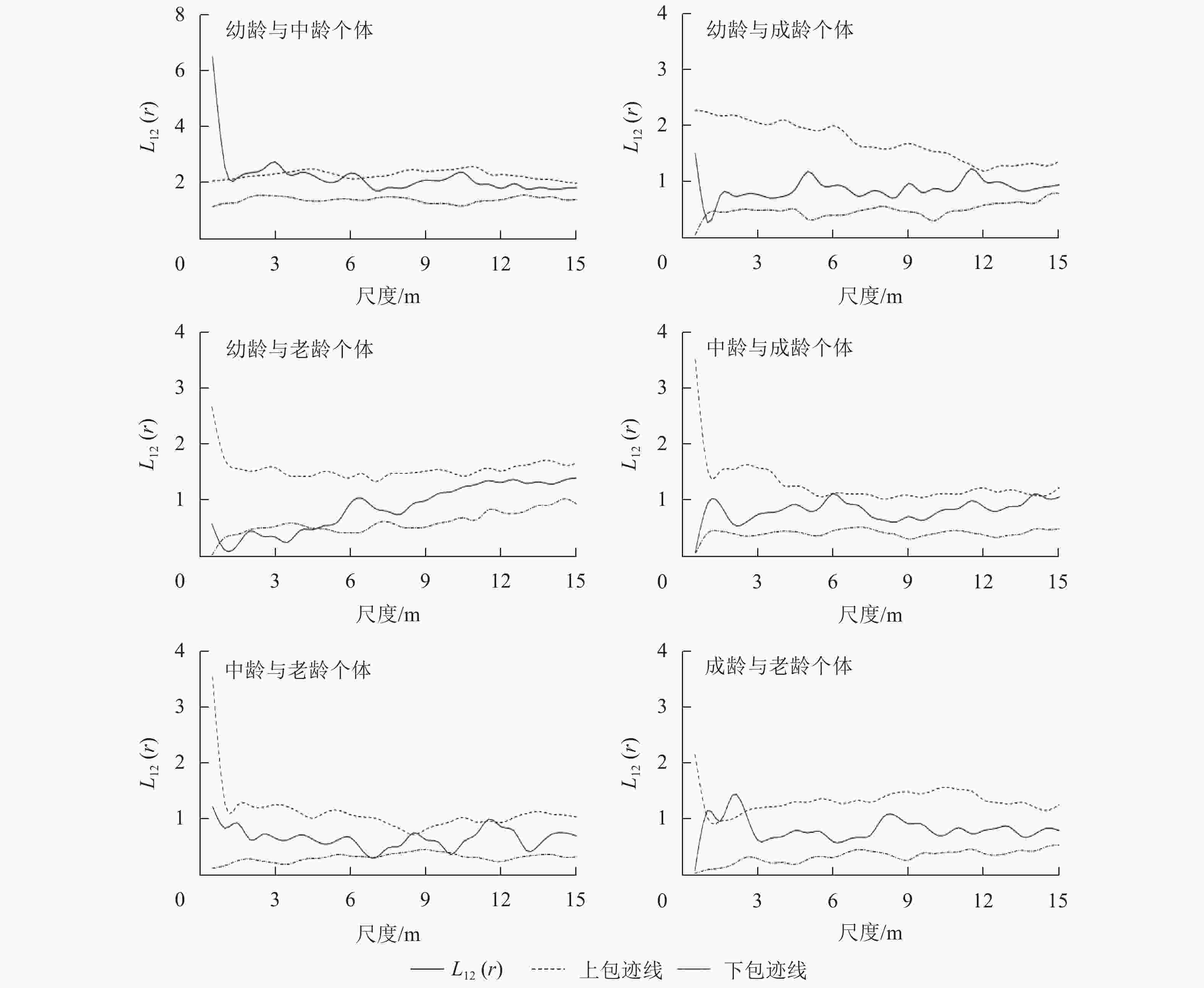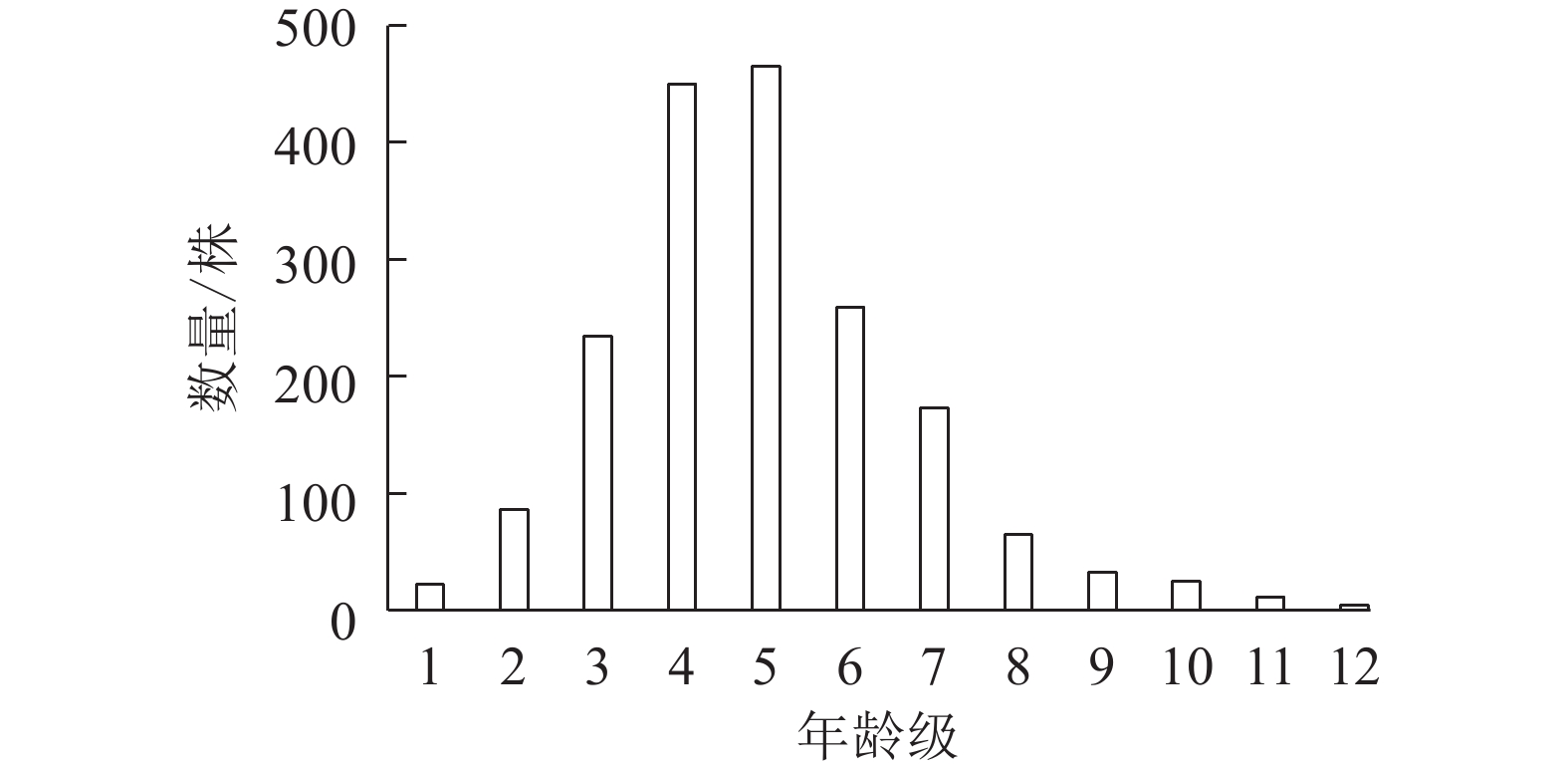-
种群空间分布格局是指种群内个体在特定空间内的分布状况,受到种群生物学、种间关系、环境等诸多因素影响[1]。构成种群的空间分布特征类型有种群点格局分布和空间关联性2种类型[2−3]。种群点格局总体上可以分为3种:随机分布、均匀分布和聚集分布[4];而种间关联则有3种基本类型:空间正关联、空间无关联、空间负关联[5]。不同的分布类型和联系模式反映了种群间的不同生态关系[6]。因此,研究种群的空间分布格局特点,既可以认识其生物学特点,又可以掌握其在环境资源中的协调作用[7−10]。如学者对宁夏六盘山辽东栎Quercus wutaishansea [11]、广东雷州半岛无患子Sapindus saponaria[12]、桂林岩溶石山檵木Loropetalum chinense[13]和浙江天目山紫楠Phoebe sheareri[14]等进行了种群的空间分布格局及其关联性的点格局分析。
新疆野苹果Malus sieversii为蔷薇科Rosaceae苹果属Malus乔木,是新疆野果林的主要建群种之一[15],目前已经被列为中国具有国际意义的生物多样性优先保护物种和中国濒危二级重点保护植物[16]。在国内新疆野苹果主要分布于新疆的西部山区[17],通常在河谷的底部或峡谷的阴坡,呈带状、片状或块状分布[18]。但近年来,由于受到病虫害、过度放牧和人类活动频繁等影响[19],新疆野苹果的生存环境遭到破坏,资源不断减少,已处于濒危和灭绝的边缘[20]。以往关于新疆野苹果的研究大多基于遗传繁殖特性和抗逆性等,研究地点也多集中于伊犁河谷一带,对于其他区域内新疆野苹果种群空间分布格局及空间关联性方面的研究则相对较少。因此,本研究以新疆塔城地区额敏县新疆野苹果种群为对象,通过样地调查法,探究新疆野苹果种群的空间分布格局及空间关联性,以期为珍稀野生果树资源的保护提供参考。
-
在研究区内,选择不同立地条件,不同地理特性的生境,建立20块面积为30 m×30 m的标准样地,调查样地内所有乔木的种类、数量、胸径、树高、空间位置、冠幅、长势、健康状况等信息,并进行记录,共统计到乔木有1 063株,乔木层的平均密度为885.83株·hm−2,样地详细信息见表1。
表 1 样地基础信息表
Table 1. Sample plot basic information table
样地编号 纬度(N) 经度(E) 海拔/m 坡度/(°) 坡位 坡向 1 46°22′45″ 83°59′35″ 1 279 16 上 西南 2 46°23′02″ 83°59′33″ 1 274 22 上 东 3 46°23′09″ 83°59′03″ 1 249 27 中 西南 4 46°22′13″ 84°00′10″ 1 318 18 下 东北 5 46°22′31″ 83°59′40″ 1 339 14 中 东南 6 46°22′22″ 84°00′24″ 1 282 20 中 西南 7 46°22′15″ 83°59′52″ 1 242 17 上 北 8 46°22′02″ 83°59′50″ 1 217 24 下 东 9 46°22′12″ 83°59′10″ 1 187 21 上 西南 10 46°22′04″ 83°58′23″ 1 171 25 上 东北 11 46°23′16″ 83°58′15″ 1 219 16 下 东 12 46°22′14″ 83°59′31″ 1 236 20 中 西北 13 46°21′43″ 84°00′04″ 1 341 23 下 东北 14 46°21′54″ 84°00′21″ 1 305 26 下 东北 15 46°23′17″ 83°59′32″ 1 163 29 中 南 16 46°23′06″ 84°00′14″ 1 154 19 下 东南 17 46°23′11″ 83°59′53″ 1 188 32 上 西南 18 46°23′30″ 83°59′39″ 1 084 22 中 西南 19 46°23′13″ 83°57′35″ 958 25 下 西北 20 46°23′28″ 83°56′34″ 911 20 中 东南 -
本研究采用径级结构代替年龄结构的方法,分析种群的年龄结构[25−27]。参考刘忠权等[28]对新疆野苹果年龄级的划分方法,按照胸径(d)划分为:1级(0<d≤5 cm)、2级(5 cm<d≤10 cm)、3级(10 cm<d≤15 cm)、4级(15 cm<d≤20 cm)、5级(20 cm<d≤25 cm)、6级(25 cm<d≤30 cm)、7级(30 cm<d≤35 cm)、8级(35 cm<d≤40 cm)、9级(40 cm<d≤45 cm)、10级(45 cm<d≤50 cm)、11级(50 cm<d≤55 cm)、12级(d>55 cm)。以此为龄级划分标准,统计各个样地中不同龄级新疆野苹果株数,组成种群年龄结构基本数据,并以龄级为横坐标,以新疆野苹果在龄级范围内的个体数为纵坐标,绘制种群年龄结构图。根据新疆野苹果的生长发育特点,可以将1~3龄级划分为幼龄个体,其中1龄级个体划分为幼苗,2龄级个体划分为幼树,3龄级个体划分为小树;将4~6龄级划分为中龄个体;将7~9龄级划分为成龄个体;将10~12龄级划分为老龄个体。
-
本研究采用Ripley K单变量K(r)函数对新疆野苹果不同龄级个体间的空间分布类型进行点格局分析,K(r)函数法是对种群空间分布格局分析最常用的方法,能够以植物个体的空间位置为基础,同时对任意研究尺度的空间分布格局进行分析,反映种群生态特征[29]。具体公式如下:
$$ K\left(r\right)=\frac{A}{{n}^{2}}\sum _{i=1}^{n}\sum _{j=1}^{n}\frac{Ir\left({u}_{ij}\right)}{{W}_{ij}}\left(i\ne 1\right)。 $$ (1) 式(1)中:A为样地面积;n为所有林木的总株数;
$ r $ 为空间尺度;$ {u}_{ij} $ 为第$ i $ 株林木到$ j $ 株林木的距离;当$ I $ 为指数函数,$ {u}_{ij} $ ≤$ r $ 时,$ Ir\left({u}_{ij}\right)=1 $ ;当$ I $ 为指数函数,$ {u}_{ij} $ >$ r $ 时,$ Ir\left({u}_{ij}\right)=0 $ ;$ {W}_{ij} $ 是以$ i $ 点为圆心、$ {u}_{ij} $ 为半径的圆落在面积A中的弧长与整个圆周的比例。为了更直观地解释实际的空间格局,采用L(r)函数代替K(r)函数,通常L(r)函数值可判断空间尺度内研究对象的分布类型,来确定种群的空间分布类型。公式如下:
$$ L\left(r\right)=\sqrt{K\left(r\right)/{\text{π}} }-r。 $$ (2) 式(2)中:当
$ L\left(r\right)=0 $ 时,物种在r尺度上服从随机分布;当$ L\left(r\right) < 0 $ 时,服从均匀分布;当$ L\left(r\right) > 0 $ 时,服从聚集分布。 -
应用Ripley K双变量
$ {K}_{12}\left(r\right) $ 函数对不同发育阶段新疆野苹果的点格局进行分析,研究距离尺度r内的不同发育阶段的个体数目,就是对$ {K}_{12}\left(r\right) $ 的求解,以此对不同龄级间新疆野苹果种群的空间关联性进行分析。具体公式如下:$$ {K}_{12}\left(r\right)=\frac{A}{{n}_{1}\times {n}_{2}}\sum _{i=1}^{n}\sum _{j=1}^{n}\frac{Ir\left({u}_{ij}\right)}{{W}_{ij}}\left(i\ne j\right)。 $$ (3) 式(3)中:
$ {n}_{1} $ 、$ {n}_{2} $ 为样地内新疆野苹果不同龄级个体数量,其他指标与式(1)的意义相同。按照上述方法对
$ {K}_{12} $ 进行平方根转化,得到$ {L}_{12} $ 函数,具体公式如下:$$ {L}_{12}\left(r\right)=\sqrt{{K}_{12}\left(r\right)/{\text{π}} }-r 。 $$ (4) 通过判断函数值
$ L\left(r\right) $ 和参数值$ {L}_{12}\left(r\right) $ 与包迹线之间的位置关系,确定新疆野苹果种群的空间分布格局及其关联性。若函数值$ L\left(r\right) $ 在上包迹线上则为聚集分布,在上下包迹线之间则为随机分布,在下包迹线下则为均匀分布。如果函数值$ {L}_{12}\left(r\right) $ 在上包迹线上呈正相关,在上下包迹线之间呈不相关,在下包迹线下呈负相关。 -
由图1可知:新疆野苹果年龄结构呈先增加后减少的变化趋势,第1、2、3、4龄级植株数量逐步增加,在第5龄级时达到峰值,此后个体数量逐步下降,到第12龄级达到最小值。总体上来看,新疆野苹果年龄结构呈现类似纺锤形的底部较宽而顶部极窄的不规则金字塔型。其中,第5龄级个体数占总量的25.44%,幼龄个体缺失较为明显,种群结构不稳定。
-
从图2可以看出:幼龄阶段个体在0~1.00、2.75~3.50、5.80~6.20、7.00~7.50、9.00~10.00、11.50~12.50、13.50~15.00 m尺度上呈聚集分布,其他尺度均呈随机分布;中龄阶段个体在0~1.00、2.50~5.00和7.50~10.50 m尺度上呈聚集分布,在1.25~2.00、6.25~7.25和12.00~13.50 m尺度上呈均匀分布,其他尺度上则呈随机分布;成龄阶段个体大致为随机分布,只有在7.80~8.20 m尺度上呈聚集分布;而老龄阶段个体则全部呈随机分布状态。总体来看,不同年龄阶段新疆野苹果个体在较小尺度内大多数都表现为随机分布,小部分表现为聚集分布。较小年龄个体中部分会呈现聚集分布状态,随着年龄阶段的不断增加,逐渐趋向随机分布。
-
从图3可以看出:新疆野苹果种群4个年龄阶段个体间的空间关联格局存在一定差异。幼龄个体与中龄个体在0~3.00、5.50~6.50 m尺度上呈正关联,其余尺度上均呈无关联状态,随着尺度的增加,关联性逐渐增强;幼龄个体与成龄个体在1.00~1.50 m尺度上呈微弱负关联,其余尺度均无明显关联;幼龄个体与老龄个体在1.00~4.50 m尺度上呈负关联状态,其余阶段均无明显关联;中龄个体与成龄个体在6.00和14.00 m尺度上呈微弱正关联,其余尺度上均呈无关联状态;中龄个体与老龄个体总体上呈无关联状态;而成龄阶段个体和老龄阶段个体在1.00~2.50 m尺度上呈正关联,其余尺度上呈无关联状态。整体来说,年龄相近的个体空间关联性多呈正关联或无显著关联,随着个体年龄间差距的增加,它们之间的空间关联性转为无关联或负关联状态。
-
植被的空间分布格局受径级、尺度大小的影响,其生态学特性在不同尺度和径级上表现不同的差异[30−31]。有研究显示:种群空间结构的改变显示了种群的生存策略和应对机制,有利于群体获得更好的资源[32]。种群空间分布格局和空间尺度规模有很大的联系,在较小的范围内,种群的分布可能是集中的,但在较大的范围内,种群的分布可以是随机或均匀的[33]。一般以母株为核心的繁殖物种,会呈现集中的分布形态,而随着个体的成长,对环境的需求则会逐渐增大,再加上物种之间的竞争以及年龄的增加,这些物种利用的空间变小,就会为了生存资源扩大生存空间,使种群逐渐呈现随机分布状态。本研究发现:新疆野苹果幼龄和中龄个体为局部集中分布,随着年龄的增长呈随机分布趋势,这与区域密度限制导致的死亡有一定关系,新疆野生苹果主要是自然更新,由于种子的散布和扩散方式有限,自然更新的幼苗通常集中在母树周围,因此,种子萌发会使其活立木的空间格局呈现集中分布。然而,由于生长过程中不断的自然更新,个体对生存空间和营养的需求不断增加,竞争日益加剧,导致个体不断死亡、淘汰,个体逐渐趋向于随机分布的态势,这与新疆野苹果种群年龄结构中老龄个体缺失明显的特点相一致。
种群的生态学关系表现为种群的空间关联性。在种间关联理论中,正向关联是指物种之间的相互依赖,或者是同一环境中的物种,它们对环境的适应性表现;负向关联则是指物种在环境中进行资源获取时相互竞争所产生的差异性表现[34]。新疆野苹果各龄级个体间在小尺度内存在正、负的相关关联性,且随着规模尺度的增大,其空间关联度逐渐降低,且趋向于无关联态势。这是由于植物之间的交互作用大多集中在十几米的区域,超过了这个区域范围,植株之间的交互作用就会大大降低,这种特性反映了种群的空间格局具有尺度依赖性[35]。因此,在未来的研究中可以扩大样地面积范围,进行额敏县新疆野苹果纯林的种群格局分析。
此外,本研究还发现:随着年龄差异的增加,其空间关联性更多地呈现无关联态,这可能是由于新疆野苹果幼龄个体不耐荫,且对由大树所创造的高郁闭度的环境适应能力较差,而新疆野苹果种群中的主要成龄个体多为随机或非空间关联,这反映了其内部的不良生态关系。今后应加强对新疆野苹果种群幼苗的抚育管理和人工干预保护。
-
额敏县新疆野苹果种群的年龄结构呈现类似纺锤形的非典型金字塔型,其种群随着年龄的增加,逐渐趋向随机分布,随着尺度的增加,逐渐趋向均匀分布,随着个体年龄间差距的增加,它们之间的空间关联性转为无关联或负关联状态。额敏县新疆野苹果种群更新不良,种群结构不稳定,因此今后应当通过人工抚育措施,改变新疆野苹果种群年龄结构和分布方式,使其得以长期稳定的发展。
Spatial pattern and correlation of Malus sieversii population in Emin County
-
摘要:
目的 研究新疆塔城地区额敏县新疆野苹果Malus sieversii种群空间分布格局及其关联性,为该地区新疆野苹果种群恢复和持续经营提供科学依据。 方法 通过典型样地调查法,设置20块标准样地(30 m×30 m)进行新疆野苹果个体调查,使用径级结构代替年龄结构,并运用点格局分析中的单变量函数和双变量函数分析方法,对不同龄级新疆野苹果个体的空间分布格局及其关联性进行研究。 结果 ①新疆野苹果种群的年龄结构呈现类似纺锤形的非典型金字塔型,更新状况不良,种群结构不稳定。②较小年龄的新疆野苹果个体部分呈现出聚集分布,随着年龄的不断增加,逐渐趋向随机分布。③年龄相近的个体空间关联性部分呈正关联或无显著关联,随着个体年龄间差距的增加,空间关联性大多数表现为无关联状态。 结论 额敏县新疆野苹果种群结构不稳定,不同龄级个体之间空间关联性不强,应加强抚育管理,通过人工种植等方法改变其现有的随机分布状态,使其聚集生长,以促进当地新疆野苹果种群稳定生长及资源恢复。图3表1参35 Abstract:Objective This study, with an investigation of the spatial distribution pattern and correlation of Malus sieversii population in Emin County, Tacheng Prefecture of Xinjiang, is aimed to explore its biological characteristics so as to provide a scientific basis for the restoration and sustainable management of M. sieversii population in this area. Method First, employing the typical sample plot investigation method, an investigation was conducted of the individuals of M. sieversii in 20 blocks (30 m×30 m) with diameter class structure used instead of age structure and univariate function and bivariate function analysis methods adopted in point pattern analysis. Then, a study was carried out of the spatial distribution pattern and its correlation of M. sieversii individuals with different age classes. Result (1) The age structure of M. sieversii population presented an atypical pyramid like a spindle, with poor regeneration and unstable population structure. (2) The individual parts of M. sieversii with younger age showed aggregation distribution with the tendency to become random with the increase of age. (3) The spatial relevance of individuals with similar age is positively correlated or not significantly correlated whereas with the increase of the gap between individuals’ ages, the spatial relevance was mostly non-correlated. Conclusion The population structure of M. sieversii in Emin County is unstable, and the spatial correlation between individuals of different age classes is not strong. Therefore, efforts should be focused on the enhancement of tending management and the change of their existing random distribution state through artificial planting and other methods, so as to make them aggregate and grow and promote the stable growth of local M. sieversii population and resource recovery. [Ch, 3 fig. 1 tab. 35 ref.] -
Key words:
- Malus sieversii /
- age structure /
- spatial distribution pattern /
- spatial relevance
-
表 1 样地基础信息表
Table 1. Sample plot basic information table
样地编号 纬度(N) 经度(E) 海拔/m 坡度/(°) 坡位 坡向 1 46°22′45″ 83°59′35″ 1 279 16 上 西南 2 46°23′02″ 83°59′33″ 1 274 22 上 东 3 46°23′09″ 83°59′03″ 1 249 27 中 西南 4 46°22′13″ 84°00′10″ 1 318 18 下 东北 5 46°22′31″ 83°59′40″ 1 339 14 中 东南 6 46°22′22″ 84°00′24″ 1 282 20 中 西南 7 46°22′15″ 83°59′52″ 1 242 17 上 北 8 46°22′02″ 83°59′50″ 1 217 24 下 东 9 46°22′12″ 83°59′10″ 1 187 21 上 西南 10 46°22′04″ 83°58′23″ 1 171 25 上 东北 11 46°23′16″ 83°58′15″ 1 219 16 下 东 12 46°22′14″ 83°59′31″ 1 236 20 中 西北 13 46°21′43″ 84°00′04″ 1 341 23 下 东北 14 46°21′54″ 84°00′21″ 1 305 26 下 东北 15 46°23′17″ 83°59′32″ 1 163 29 中 南 16 46°23′06″ 84°00′14″ 1 154 19 下 东南 17 46°23′11″ 83°59′53″ 1 188 32 上 西南 18 46°23′30″ 83°59′39″ 1 084 22 中 西南 19 46°23′13″ 83°57′35″ 958 25 下 西北 20 46°23′28″ 83°56′34″ 911 20 中 东南 -
[1] 郭垚鑫, 胡有宁, 李刚, 等. 太白山红桦种群不同发育阶段的空间格局与关联性[J]. 林业科学, 2014, 50(1): 9 − 14. GUO Yaoxin, HU Youning, LI Gang, et al. Spatial pattern and spatial association of Betula albosinensis at different developmental stages at Taibai Mountain [J]. Scientia Silvae Sinicae, 2014, 50(1): 9 − 14. [2] 张金屯. 数量生态学[M]. 北京: 科学出版社, 2011. ZHANG Jintun. Quantitative Ecology [M]. Beijing: Science Press, 2011. [3] 任珩. 高寒退化草地西北针茅种群空间分布格局及关联性研究[D]. 兰州: 西北师范大学, 2012. REN Heng. Study on Spatial Distribution Pattern and Spatial Associtation of Stipa krylovii Population in Alpine Degraded Grassland [D]. Lanzhou: China West Normal University, 2012. [4] 张金屯, 孟东平. 芦芽山华北落叶松林不同龄级立木的点格局分析[J]. 生态学报, 2004, 24(1): 35 − 40. ZHANG Jintun, MENG Dongping. Spatial pattern analysis of individuals in different age classes of Larix principis rupprechtii in Luya mountain reserve, Shanxi, China [J]. Acta Ecologica Sinica, 2004, 24(1): 35 − 40. [5] 刘珏宏, 高慧, 张丽红, 等. 内蒙古锡林郭勒草原大针茅-克氏针茅群落的种间关联特征分析[J]. 植物生态学报, 2010, 34(9): 1016 − 1024. LIU Juehong, GAO Hui, ZHANG Lihong, et al. Comparative analysis of interspecific association within the Stipa grandis-S. krylovii community in typical steppe of Inner Mongolia, China [J]. Chinese Journal of Plant Ecology, 2010, 34(9): 1016 − 1024. [6] 刘振国, 李镇清. 植物群落中物种小尺度空间结构研究[J]. 植物生态学报, 2005, 29(6): 1020 − 1028. LIU Zhenguo, LI Zhenqing. Perspectives on small-scale spatial structure of plant species in plant communities [J]. Acta Phyteocologica Sinica, 2005, 29(6): 1020 − 1028. [7] HOU J H, MI X C, LIU C R, et al. Spatial patterns and associations in a Quercus-Betula forest in northern China [J]. Journal of Vegetation Science, 2004, 15: 407 − 414. [8] WIEGAND T, MOLONEY K A. Rings, circles, and null models for point pattern analysis in ecology [J]. Oikos, 2004, 104: 209 − 229. [9] NATHAN R. Long-distance dispersal of plants [J]. Science, 2006, 313: 786 − 788. [10] WANG Xugao, YE Ji, LI Buhang, et al. Spatial distributions of species in an old-growth temperate forest, northeastern China [J]. Canadian Journal of Forest Research, 2010, 40: 1011 − 1019. [11] 张中惠, 郭建斌, 王彦辉, 等. 六盘山辽东栎林种群结构和空间分布格局[J]. 浙江农林大学学报, 2021, 38(6): 1091 − 1099. ZHANG Zhonghui, GUO Jianbin, WANG Yanhui, et al. Population structure and spatial distribution pattern of Quercus wutaishanica in Liupan Mountains [J]. Journal of Zhejiang A&F University, 2021, 38(6): 1091 − 1099. [12] 谢锭淇, 黄锐洲, 许涵, 等. 雷州半岛风水林中无患子的空间分布格局与空间关联性[J]. 热带亚热带植物学报, 2022, 30(1): 31 − 40. XIE Dingqi, HUANG Ruizhou, XU Han, et al. Spatial distribution pattern and association of Sapindus saponaria in Fengshui forest, Leizhou Peninsula [J]. Journal of Tropical and Subtropical Botany, 2022, 30(1): 31 − 40. [13] 涂洪润, 李娇凤, 刘润红, 等. 桂林岩溶石山檵木种群空间格局及其关联性[J]. 应用生态学报, 2019, 30(8): 2621 − 2630. TU Hongrun, LI Jiaofeng, LIU Runhong, et al. Spatial distribution patterns and association of Loropetalum chinense population in karst hills of Guilin, Southwest China [J]. Chinese Journal of Applied Ecology, 2019, 30(8): 2621 − 2630. [14] 范忆, 楼一恺, 库伟鹏, 等. 天目山紫楠种群年龄结构与点格局分析[J]. 浙江农林大学学报, 2020, 37(6): 1027 − 1035. FAN Yi, LOU Yikai, KU Weipeng, et al. Age structure and spatial point pattern of Phoebe sheareri population in Mount Tianmu [J]. Journal of Zhejiang A&F University, 2020, 37(6): 1027 − 1035. [15] 闫鹏, 韩立群, 梅闯, 等. 新疆野苹果(Malus sieversii (ledeb. ) M. Roem.) 植物学性状遗传多样性及相关性分析[J]. 植物遗传资源学报, 2016, 17(4): 683 − 689. YAN Peng, HAN Liqun, MEI Chuang, et al. Genetic diversity and correlation analysis of botanical characters in Xinjiang wild apple (Malus sieversii (ledeb. ) M. Roem.) [J]. Journal of Plant Genetic Resources, 2016, 17(4): 683 − 689. [16] 马闯, 杨美玲, 张云秀, 等. 新疆野苹果 (Malus sieversii)种群年龄结构及其动态特征[J]. 干旱区研究, 2018, 35(1): 156 − 164. MA Chuang, YANG Meiling, ZHANG Yunxiu, et al. Age composition and dynamic characteristics of the main populations of endangered Malus sieversii [J]. Arid Zone Research, 2018, 35(1): 156 − 164. [17] YAN Guorong, LONG Hong, SONG Wenqin, et al. Genetic polymorphism of Malus sieversii populations in Xinjiang, China [J]. Genetic Resources and Crop Evolution, 2008, 55(1): 171 − 181. [18] 侯博, 许正. 天山野果林的发生、演变与气候因素的关系[J]. 西北植物学报, 2005, 25(11): 2266 − 2271. HOU Bo, XU Zheng. Relationship of the occurences and evolutions of wild fruit forests with climatic factors in the Tianshan Mountain [J]. Acta Botanica Boreali-Occidentalia Sinica, 2005, 25(11): 2266 − 2271. [19] 张苹, 吕昭智, 张鑫, 等. 新疆伊犁与哈萨克斯坦新疆野苹果 (Malus sieversii (Ledeb. ) Roem. ) 种群年龄结构[J]. 干旱区研究, 2019, 36(4): 844 − 853. ZHANG Ping, LÜ Zhaozhi, ZHANG Xin, et al. Age structure of Malus sieversii population in Ili of Xinjiang and Kazakhstan [J]. Arid Zone Research, 2019, 36(4): 844 − 853. [20] 刘彬. 新疆野苹果 (Malus sieversii) 生态调查及生长发育的生物学基础研究[D]. 天津: 天津农学院, 2016. LIU Bin. Ecological Investigation and Biological Basis of Growth and Development of Malus sieversii[D]. Tianjin: Tianjin Agricultural University, 2016. [21] 段小兵, 努尔巴依·阿布都沙力克. 新疆巴尔鲁克山自然保护区野生植物资源研究[J]. 安徽农业科学, 2011, 39(10): 5996 − 5999. DUAN Xiaobin, Nuerbayi Abudukeli. Research on wild plant resources in Barluk Mountain Natural Reserve of Xinjiang [J]. Journal of Anhui Agricultural Sciences, 2011, 39(10): 5996 − 5999. [22] 王泽华. 不同居群新疆野苹果抗寒性研究[D]. 乌鲁木齐: 新疆农业大学, 2017. WANG Zehua. Study on Cold Resistance of Malus sieversii in Different Populations[D]. Urumqi: Xinjiang Agricultural University, 2017. [23] 王昆, 刘凤之, 高源, 等. 中国苹果野生种自然地理分布、多型性及利用价值[J]. 植物遗传资源学报, 2013, 14(6): 1013 − 1019. WANG Kun, LIU Fengzhi, GAO Yuan, et al. The natural distribution, diversity, and utilization of wild apple species in China [J]. Journal of Plant Genetic Resources, 2013, 14(6): 1013 − 1019. [24] 刘立诚, 排祖拉, 徐华君. 新疆伊犁和塔城地区野果林下土壤特性及系统分类研究[J]. 土壤通报, 1999, 30(4): 153 − 156. LIU Licheng, PAI Zula, XU Huajun. Study on soil characteristics and systematic classification under wild fruit forest in Yili and Tacheng areas, Xinjiang [J]. Chinese Journal of Soil Science, 1999, 30(4): 153 − 156. [25] LEAK W B. An expression of diameter distribution for unbalanced, uneven-aged stands and forests [J]. Forest Science, 1964, 10(1): 39 − 50. [26] 洪伟, 王新功, 吴承祯, 等. 濒危植物南方红豆杉种群生命表及谱分析[J]. 应用生态学报, 2004, 15(6): 1109 − 1112. HONG Wei, WANG Xingong, WU Chengzhen, et al. Life table and spectral analysis of endangered plant Taxus chinensis var. mairei population [J]. Chinese Journal of Applied Ecology, 2004, 15(6): 1109 − 1112. [27] 江波, 周先容, 尚进, 等. 中国特有植物巴山榧树的种群结构与动态[J]. 生态学报, 2018, 38(3): 1016 − 1027. JIANG Bo, ZHOU Xianrong, SHANG Jin, et al. Population structure and dynamics of Torreya fargesii Franch. a plant endemic to China [J]. Acta Ecologica Sinica, 2018, 38(3): 1016 − 1027. [28] 刘忠权, 董合干, 梁巧玲, 等. 孑遗植物新疆野苹果种群生命表与生存分析[J]. 干旱区资源与环境, 2016, 30(10): 98 − 103. LIU Zhongquan, DONG Hegan, LIANG Qiaoling, et al. Analysis on the survival table of relict plants and Malus sieversii populations [J]. Journal of Arid Land Resources and Environment, 2016, 30(10): 98 − 103. [29] RIPLEY B D. Spatial Statistics[M]. New York: Wiley, 1981. [30] 马克明, 祖元刚. 植被格局的分形模型: 植被格局的分形特征[J]. 植物生态学报, 2000, 24(1): 111 − 117. MA Keming, ZU Yuangang. Fractal properties of vegetation pattern [J]. Acta Phytoecologica Sinica, 2000, 24(1): 111 − 117. [31] LAN Guoyu, GETZIN S, WIEGAND T, et al. Spatial distribution and interspecific associations of tree species in a tropical seasonal rain forest of China [J/OL]. PLoS One, 2012, 7(9): e46074[2022-04-01]. doi: 10.1371/journal.pone.0046074. [32] 杨君珑, 王辉, 王彬, 等. 子午岭油松林灌木层主要树种的空间分布格局和种间关联性研究[J]. 西北植物学报, 2007, 27(4): 4791 − 4796. YANG Junlong, WANG Hui, WANG Bin, et al. Spatial distribution pattern and interspecific association of main tree spacies in Pinus tabuliformis forest in Ziwuling Mountains [J]. Acta Botanica Boreali-Occidentalia Sinica, 2007, 27(4): 4791 − 4796. [33] 胡文强, 黄世能, 李家湘, 等. 南岭石坑崆山顶矮林乔木优势种群的种间关联性[J]. 生态学杂志, 2013, 32(10): 2665 − 2671. HU Wenqiang, HUANG Shineng, LI Jiaxiang, et al. Interspecific associations among dominant tree populations in an elfinforest community in Shikengkong of Nanling Mountains, China [J]. Chinese Journal Ecology, 2013, 32(10): 2665 − 2671. [34] GRAY L, HE Fangliang. Spatial point-pattern analysis for detecting density-dependent competition in a boreal chronosequence of Alberta [J]. Forest Ecology and Management, 2009, 259(1): 98 − 106. [35] CONDIT R, ASHTON P S, BAKER P, et al. Spatial patterns in the distribution of tropical trees species [J]. Science, 2000, 288: 1414 − 1418. -

-
链接本文:
https://zlxb.zafu.edu.cn/article/doi/10.11833/j.issn.2095-0756.20220267







 下载:
下载:




































